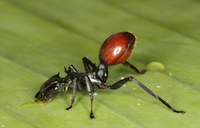Research
Research in the Yanoviak lab is a blend of behavioral, evolutionary, and community ecology. We conduct field-based observational and experimental investigations addressing three general questions: 1) How do species interactions and anthropogenic disturbance shape local biodiversity?; 2) What selective pressures shape the behavior and morphology of arboreal organisms?; and 3) How do ecological patterns in the forest canopy relate to those in the understory? Most of our current work is located in the neotropics and focuses on arthropods, especially ants. Below are some recent and ongoing projects:
Gliding Arthropods - Aerial gliding behavior occurs in various wingless vertebrates, including mammals, snakes, lizards, and frogs. However, gliding was unknown in terrestrial arthropods until it was described for arboreal ants in 2005. Since then, we have been collaborating with Dr. Robert Dudley's lab to understand the aerodynamic mechanisms and evolutionary relevance of gliding behavior in various arthropod taxa. Please feel free to use our videos of gliding ants for educational purposes. Selected publications: 21, 24, 28, 31, 37, 44, 48
Canopy Ant Diversity - Canopy-litter comparisons suggest that the relatively linear, reticulate structure of tree crowns shapes the behavior and ecology of arboreal ants (Yanoviak & Kaspari 2000). Currently, we are examining how different components of the forest canopy (epiphytes, lianas) influence local ant diversity. In particular, lianas are an important element of lowland tropical forests and are increasing in abundance due to a variety of factors, including climate change. We are collaborating with Dr. Stefan Schnitzer on his large scale liana removal project in Panama to determine how such changes will affect canopy ant community structure. Selected publications: 08, 13, 15, 17, 27, 29, 40, 46, 51
Litter Arthropods - Leaf litter supports diverse arthropod assemblages that interact with each other and with decomposers (bacteria & fungi). Thus litter arthropods are key elements of carbon and nutrient cycling in terrestrial ecosystems. In collaboration with Dr. Mike Kaspari, we are exploring trophic and stoichiometric patterns in litter communities to better understand their effects on large scale ecological processes. Selected publications: 34, 35, 38, 39
Berry Ants - Some parasites manipulate the appearance and behavior of their hosts to facilitate transmission to subsequent hosts. In 2008 we reported an amazing case of canopy ant (Cephalotes atratus) manipulation by a nematode parasite (Myrmeconema neotropicum), in which the parasite causes the ant to resemble ripe berries. In collaboration with Dr. George Poinar, Jr. and others, we continue to study the mechanisms and consequences of this remarkable symbiotic relationship. Selected publications: 32, 33, 42, 45, 49
Phytotelmata - Plant-held waters support highly interactive, experimentally tractable arthropod assemblages that include various potential disease vectors. Our ongoing studies in collaboration with Dr. Ola Fincke and others focus on the behavioral ecology of top predators in Neotropical water-filled tree holes. Specifically, we are exploring how interactions among predators affect community structure in these systems. Selected publications: 03, 04, 07, 11, 22, 23
